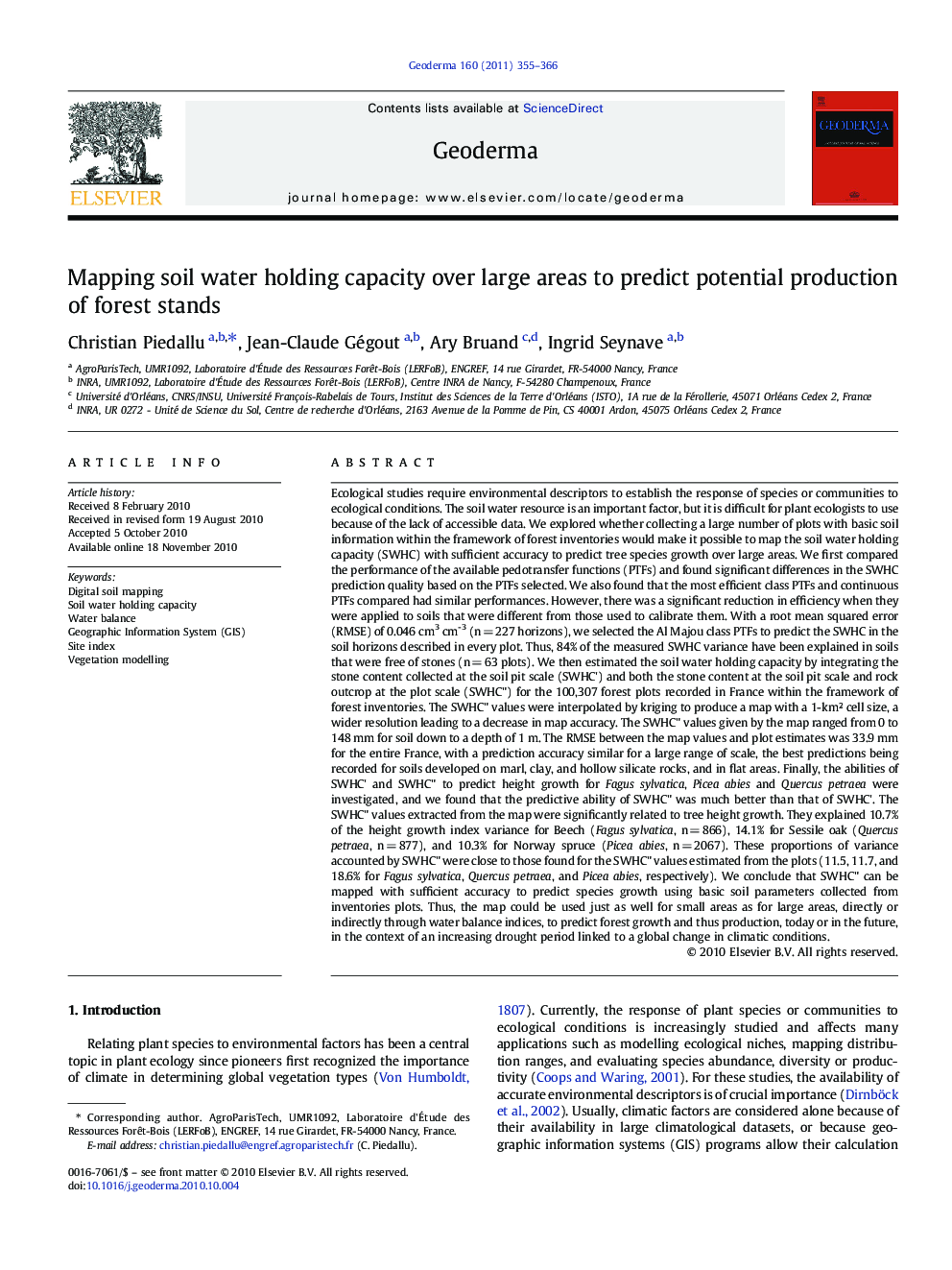| Article ID | Journal | Published Year | Pages | File Type |
|---|---|---|---|---|
| 4574251 | Geoderma | 2011 | 12 Pages |
Ecological studies require environmental descriptors to establish the response of species or communities to ecological conditions. The soil water resource is an important factor, but it is difficult for plant ecologists to use because of the lack of accessible data. We explored whether collecting a large number of plots with basic soil information within the framework of forest inventories would make it possible to map the soil water holding capacity (SWHC) with sufficient accuracy to predict tree species growth over large areas. We first compared the performance of the available pedotransfer functions (PTFs) and found significant differences in the SWHC prediction quality based on the PTFs selected. We also found that the most efficient class PTFs and continuous PTFs compared had similar performances. However, there was a significant reduction in efficiency when they were applied to soils that were different from those used to calibrate them. With a root mean squared error (RMSE) of 0.046 cm3 cm-3 (n = 227 horizons), we selected the Al Majou class PTFs to predict the SWHC in the soil horizons described in every plot. Thus, 84% of the measured SWHC variance have been explained in soils that were free of stones (n = 63 plots). We then estimated the soil water holding capacity by integrating the stone content collected at the soil pit scale (SWHC') and both the stone content at the soil pit scale and rock outcrop at the plot scale (SWHC") for the 100,307 forest plots recorded in France within the framework of forest inventories. The SWHC" values were interpolated by kriging to produce a map with a 1-km² cell size, a wider resolution leading to a decrease in map accuracy. The SWHC" values given by the map ranged from 0 to 148 mm for soil down to a depth of 1 m. The RMSE between the map values and plot estimates was 33.9 mm for the entire France, with a prediction accuracy similar for a large range of scale, the best predictions being recorded for soils developed on marl, clay, and hollow silicate rocks, and in flat areas. Finally, the abilities of SWHC' and SWHC" to predict height growth for Fagus sylvatica, Picea abies and Quercus petraea were investigated, and we found that the predictive ability of SWHC" was much better than that of SWHC'. The SWHC" values extracted from the map were significantly related to tree height growth. They explained 10.7% of the height growth index variance for Beech (Fagus sylvatica, n = 866), 14.1% for Sessile oak (Quercus petraea, n = 877), and 10.3% for Norway spruce (Picea abies, n = 2067). These proportions of variance accounted by SWHC" were close to those found for the SWHC" values estimated from the plots (11.5, 11.7, and 18.6% for Fagus sylvatica, Quercus petraea, and Picea abies, respectively). We conclude that SWHC" can be mapped with sufficient accuracy to predict species growth using basic soil parameters collected from inventories plots. Thus, the map could be used just as well for small areas as for large areas, directly or indirectly through water balance indices, to predict forest growth and thus production, today or in the future, in the context of an increasing drought period linked to a global change in climatic conditions.
Research Highlights►First production of a relatively fine spatial resolution map of SWHC over a large area. ►SWHC can be mapped using basic soil parameters collected from inventories plots. ►SWHC is significantly related to tree height growth. ►SWHC map perform close to estimates based on plots for predicting tree productivity. ►Taking into account rock outcrop improve SWHC estimation.
